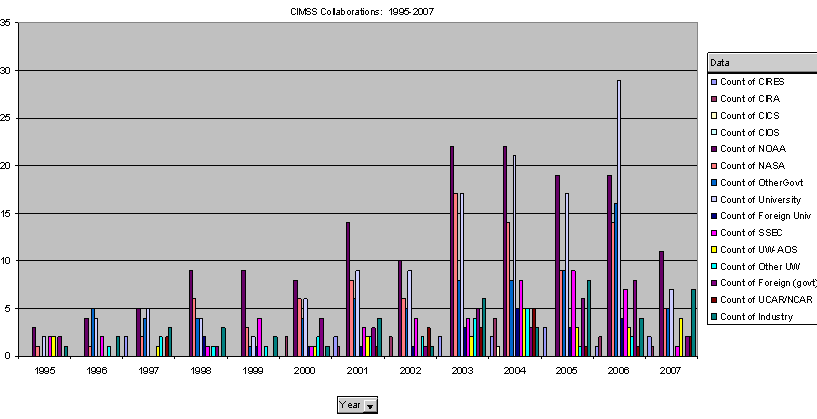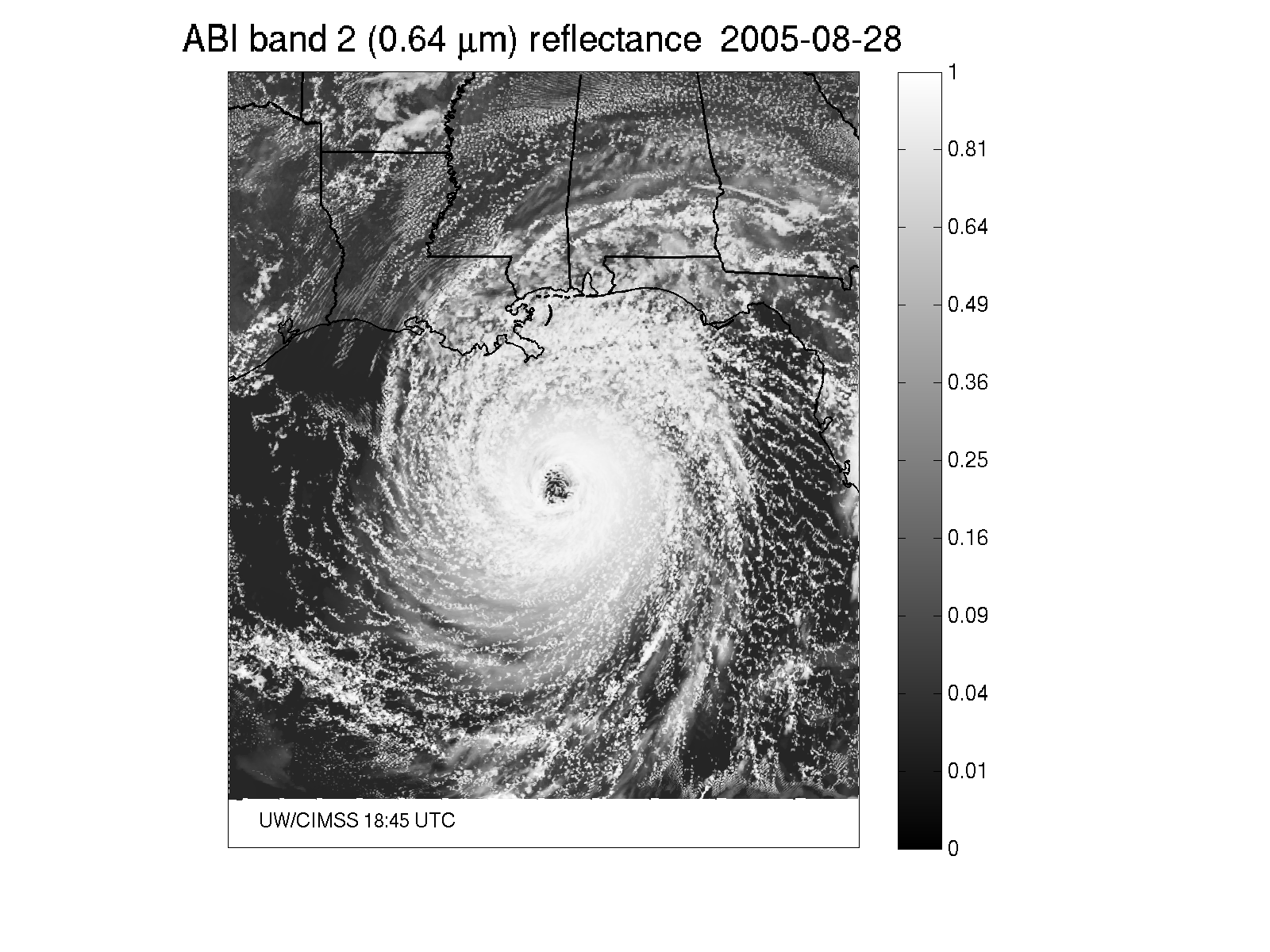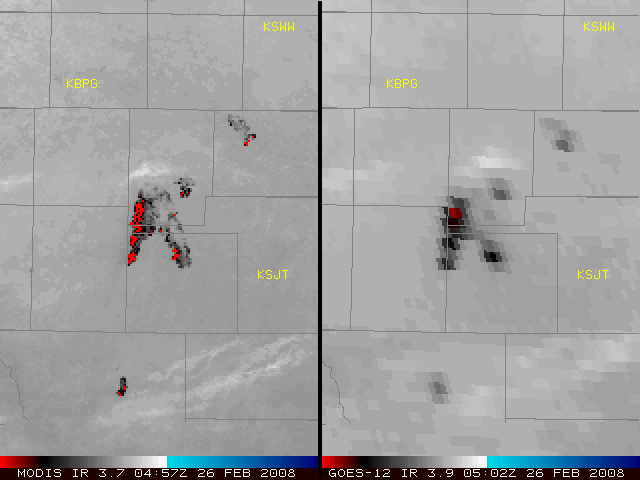 |
ASPB and CIMSS Weekly Report
[ Archive ] |
 |
ASPB AND CIMSS WEEKLY HIGHLIGHTS FOR THE WEEK ENDING MARCH 1, 2008
IN THE PRESS:
ITEMS FOR THE ADMINISTRATOR:
ITEMS FOR THE ASSISTANT ADMINISTRATOR:
ITEMS FOR THE OFFICE DIRECTOR, STAR:
GIFTS Data Compression Presentation and Demonstration at NASA Langley Research Center: Bormin
Huang of the Cooperative Institute for Meteorological Satellite Studies
(CIMSS) gave the Geosynchronous Imaging Fourier Transform Spectrometer
(GIFTS) data compression presentation and demonstration at the NASA
Langley Research Center (LaRC) on 27 February 2008. GIFTS, led by NASA
LaRC, is a technology breakthrough to simultaneously measure 16384
infrared spectra in two bands (4.4 to 6.0 micron and 8.8 to 14.6
micron) at a spectral resolution of ~0.57 wavenumbers for a 128x128 set
of ~4 km footprints at every 11 seconds in a nominal operating mode.
Based on the compression experiments on the GIFTS uplooking data
collected in September 2006, CIMSS developed a state-of-the-art
algorithm that provides a lossless, effective, efficient, and low-cost
solution to compress such GIFTS data within 6.2 seconds with an average
compression ratio of 4.54 and a processing capability that costs less
than $2,000. W. L. Smith commented that "this approach should help NOAA
greatly in minimizing the cost of their ground distribution system for
their eventual operational geostationary ultra-spectral sounder". (B.
Huang, CIMSS, 608-265-2231)
First U.S.-China Meteorology Symposium: R.
Aune attended the First U.S.-China Symposium on Meteorology, February
26-28, at the National Weather Center, Norman, Oklahoma. Sponsored by
the University of Oklahoma and the Institute of Atmospheric Physics,
Chinese Academy of Sciences, the symposium focussed on mesoscale
meteorology and data assimilation. Aune presented a poster titled: "A
Real-time Mesoscale Prediction System for MODIS Direct Broadcast
Sites". He demonstrated how the numerical forecast model used at the
Cooperative Institute for Meteorological Satellite Studies (CIMSS),
known as the CIMSS Regional Assimilation System (CRAS), can be
initialized using retrieved precipitable water and cloud-top pressure
from the Moderate Resolution Infrared Spectroradiometer (MODIS),
processed at a local MODIS direct broadcast site like those found in
China, and results in improved forecasts of precipitation and clouds.
(R.Aune, E/RA2, 608-262-1071)
Article on Weather Satellites in Popular Science Magazine: "How scientists track weather from space" by Steven A. Ackerman will be published in the Astronomy Magazine special issue "Extreme Weather" (http://www.extremeweathermag.com/ext/default.aspx?c=a&id=71).
The article traces the history of weather satellites using three
intense, fast-moving November gales as examples of improving
capabilities.(S. Ackerman, CIMSS, 608-263-3647)
CIMSS' Publications: Traditional methods that
measure success in a research center are proposal success, publications
in refereed journals, conference presentatons, the number of graduating
graduate students, recognition awards, and software distribution. A
history of publications in referred journals patterns is being compiled
by librarian Jean Phillips for Cooperative Institute for Meteorological
Satellite Studies (CIMSS) authors dating from 1995 to the present using
the Science Citation Index. As part of assessing CIMSS activities, we
are exploring this publication record with respect to the institute's
mission. Two findings with regard to collaborations are: 1) Over 40% of
our publications are jointly published with NOAA scientists, and 2) )f
NOAA's cooperative institutes we collaborate in publications the most
with CIRES (14 papers) followed closely by CIRA (12 papers).
(S. Ackerman, CIMSS, 608-263-3647)
 (Click image to enlarge)
(Click image to enlarge)
Figure caption: The number of CIMSS publications in refereed journals
since 1995 categorized by the institution of co-authors (2007 is only a
partial record).
ITEMS FOR THE DIVISION CHIEF, CoRP:
SO2 paper accepted: A paper entitled "Using the GOES Sounder to Monitor Upper-level SO2 from Volcanic Eruptions" has been accepted for publication in the Journal of Geophysical Research - Atmospheres. Authors are Steven A. Ackerman, Anthony J. Schreiner, Timothy J. Schmit, Harold M. Woolf, Jun Li, and Michael Pavolonis.
(S. Ackerman, CIMSS, 608-263-3647)
New Simulated ABI Proxy Data sets for Hurricane Katrina: In support of GOES-R Algorithm Working Group (AWG) Proxy Data research activities at the Cooperative Institute for Meteorological Satellite Studies (CIMSS), a cloud resolving (1.5 km) simulation of Hurricane Katrina was performed at the National Center for Supercomputing Applications (NCSA) using the Weather Research and Forecasting (WRF) model. An example of ABI visible imagery (band 2) produced from this simulation is shown below. Imagery for other simulated ABI bands are available for viewing at http://cimss.ssec.wisc.edu/goes_r/awg/proxy/toa_radiances/katrina. (T. Greenwald, CIMSS, 608-263-3629; J. Otkin, CIMSS, 608-265-2476; J. Sieglaff, CIMSS, 608-265-5357)
 (Click image to enlarge)
(Click image to enlarge)
Figure caption: ABI visible imagery (band 2) produced with the WRF model, run at NCSA.
CIMSS VISIT Activities: The Virtual Institute for Satellite Integration Training (VISIT) distance learning lesson "Water Vapor Imagery and Potential Vorticity Analysis" was led by staff from the Cooperative Institute for Meteorological Satellite Studies (CIMSS) on February 28, 2008). Forecasters from four separate National Weather Service (NWS) forecast offices (Fort Worth, Texas; Glasgow, Montana; Las Vegas, Nevada; Marquette, Michigan) participated in the VISIT lesson. In addition, three new cases were added to the CIMSS Satellite Blog ( http://cimss.ssec.wisc.edu/goes/blog ) during the week of February 25-29, with examples of Geostationary Operational Environmental Satellite (GOES) and Moderate resolution Imaging Spectroradiometer (MODIS) imagery showing Gulf of Mexico return flow, cloud features related to sea surface temperature gradients, and wildfires in Texas. (S. Bachmeier, CIMSS, 608-263-3958)
 (Click image to enlarge)
(Click image to enlarge)
Figure caption: Comparison of 1-km resolution MODIS and 4-km resolution
GOES-12 shortwave IR imagery, demonstrating the superior fire "hot
spot" detection capability of the higher spatial resolution MODIS data
for a large (219,000 acre) fire that was burning in west Texas on
February 26, 2008.
CIMSS Annual Report to NOAA: The Cooperative Institute for Meteorological Satellite Studies (CIMSS) has delivered its Cooperative Agreement Annual Report to NOAA via grants online. Hard bound copies of the 198 page report on 17 CIMSS projects have been sent to NOAA/NESDIS/STAR leadership and to the many NOAA Program Managers who support CIMSS research. Electronic or hard copies of the report are available by contacting Tom Achtor. (T. Achtor, CIMSS, 608-263-4206, tom.achtor@ssec.wisc.edu)
Developing AWIPS at CIRA: Jordan Gerth of the Cooperative Institute for Meteorological Satellite Studies (CIMSS) travelled to the Cooperative Institute for Research in the Atmosphere (CIRA) at Colorado State University to provide on-site support for developing an Advanced Weather Interactive Processing System (AWIPS) in the research environment. During the visit, J. Gerth assisted D. Molenar (NOAA/NESDIS) and H. Gosden (CIRA) in using the Local Data Manager (LDM) to ingest AWIPS-formatted satellite data from CIMSS, and discussed the necessary steps for transitioning new satellite products into National Weather Service Forecast Offices (NWSFOs). CIMSS has been producing experimental satellite imagery for AWIPS since 2006, and delivers these images to more than a dozen NWSFOs across the United States daily via the LDM. (J. Gerth, CIMSS, 608-263-4942)
Satellite Algorithm Testbed Workshop: A Satellite Algorithm Testbed workshop was held February 26-27 at the NSOF building in Suitland, MD. The meeting was organized and chaired by Ingrid Guch and Steve Goodman. There were representatives from other NESDIS offices and four NESDIS cooperative institutes. The objective was to discuss ways to improve our ability to develop new algorithms and transition them to operations. In particular, we need to break out of the current instrument-specific funding mechanism and provide support for basic, innovative research, provide software and hardware tools to enable the development and operational implementation of new algorithms, and work with users. Andy Heidinger, Chris Velden (Cooperative Institute for Meteorological Satellite Studies), and Jeff Key attended the workshop. (J. Key, E/RA2, 608-263-2605, jkey@ssec.wisc.edu)
Manuscript on GOES-R ABI Legacy Profile Algorithm Submitted: A
manuscript entitled “Retrieving Clear Sky Atmospheric Parameters from
SEVIRI and ABI infrared radiances” has been submitted to the Journal of Geophysical Research (JGR) – Atmospheres.
Co-authors are Xin Jin, Jun Li (Cooperative Institute for
Meteorological Satellite Studies, CIMSS), Timothy J. Schmit (STAR),
Jinlong Li (CIMSS), Mitchell D. Goldberg (STAR), and James J. Gurka
(OSD). The paper describes the algorithm used for the next generation
Geostationary Operational Environmental Satellite (GOES-R) Advanced
Baseline Imager (ABI) legacy sounding product. Validation results using
Spinning Enhanced Visible and InfraRed Imager (SEVIRI), radiosondes,
European Center for Medium-range Weather Forecasting (ECMWF) analysis,
and operational Advanced Microwave Scanning Radiometer (AMSR-E)
products are also presented and discussed in the paper. (Jun Li, CIMSS,
608-262-3755)
Other Meetings and Telecons:
None.
VISITORS:
Daren Lu of Chinese Academy of Sciences Visited CIMSS: Academician
Daren Lu from the Institute of Atmospheric Physics (IAP), Chinese
Academy of Sciences, visited the Cooperative Institute for
Meteorological Satellite Studies (CIMSS) on 29 February 2008. He
discussed with Hank Revercomb (Space Science and Engineering Center
Director) and Allen Huang (CIMSS Distinguished Scientist) the
deployment of an Atmospheric Emitted Radiances Interferometer (AERI)
system in China to demonstrate its remote sensing capability in Tibetan
Plateau, which is joint research effort between CIMSS and IAP. (Allen
Huang, CIMSS, 263-5283)
NEXT WEEK:
LOOKING AHEAD:




 (Click image to enlarge)
(Click image to enlarge) (Click image to enlarge)
(Click image to enlarge)